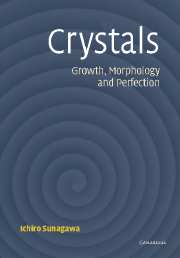Part II - Application to complicated and complex systems (case studies)
Published online by Cambridge University Press: 31 October 2009
Summary
In this second part of the book, we will present an explanation, using real examples, of how we can solve the problems involved in complicated and complex systems, based on the fundamental concepts explained in Part I and using crystal morphology as the key. Chapters 9 to 13 cover mineral crystals, and Chapter 14 discusses crystals formed in physiological activities. In particular, we discuss diamonds in Chapter 9 and quartz in Chapter 10; these are examples of minerals whose crystal morphologies have attracted deep interest from the earliest times. In Chapter 11, pyrite and calcite are selected as representative examples of mineral crystals that show elaborately varied Habitus and Tracht. Chapter 12 focuses on crystals grown from the vapor phase in free space, and the analysis will be principally based on the observations of surface microtopographs of crystal faces, imperfections, and inhomogeneities in crystals. Crystals formed in pegmatites or druses in volcanic rocks will be used as examples. In Chapter 13 our discussion will be centered on how crystal growth proceeds in the processes of metasomatism or metamorphism. In Chapter 14, biomineralization will be considered from the standpoint of crystal growth.
- Type
- Chapter
- Information
- CrystalsGrowth, Morphology, & Perfection, pp. 165 - 166Publisher: Cambridge University PressPrint publication year: 2005

